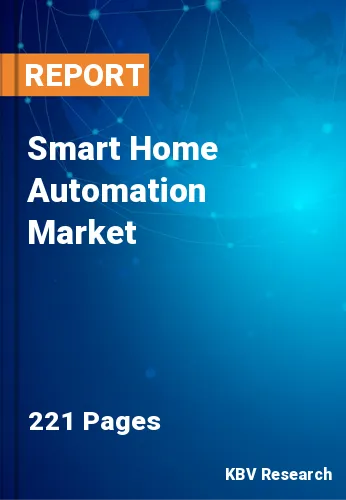The Global Smart Home Automation Market size is expected to reach $187.8 billion by 2028, rising at a market growth of 15.2% CAGR during the forecast period.
Any collection of gadgets, systems, or appliances that are connected to a single network and may operate independently and from a distance are referred to smart home automation. A connected home is a more general term for a home's technology when it functions as one system. As an illustration, the home's thermostat, lighting, audio speakers, security cameras, TVs, locks, appliances, and more are all interconnected into a single system that can be managed from a smartphone or via a mobile touch screen device.
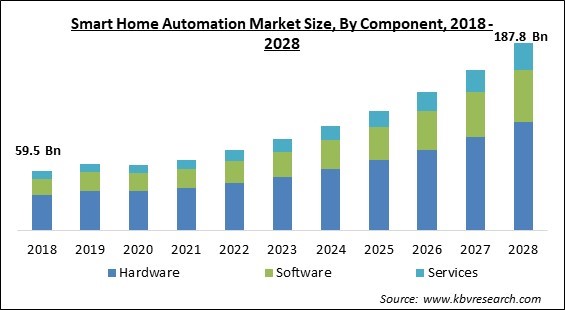
Users can access high-tech functionality and elegance that was not previously feasible owing to smart home automation. The potential for consumers' smart home automation to improve quality of life would grow as technological advancement continues. The term home automation describes the automatic as well as electronic management of functions, activities, and equipment in a home. It means users can simply control the appliances and features in the house online to increase convenience, improve security, and even reduce household expenses.
A network of communication, hardware and electronic interfaces called home automation connects commonplace devices to one another over the Internet. Whether the user is at home or away, they can control any gadget through either a smartphone or a tablet because they all have sensors and are Wi-Fi connected. It allows users to manage a lot of functions, including turning on the lights, locking a door, or even managing the temperature of their home.
Moreover, convenience is a major consideration in the context of smart home automation. A huge advance in technology and home management is being able to keep everything connected through a single interface. Essentially, all a user needs to do to access innumerable features and devices across the smart home is to learn the operation and the utilization of a single app on any smartphone or tablet. Smart home automation technology has a very low learning curve, which allows users of every age group to access this technology. This is making it significantly popular all over the world.
Due to an uncertain supply chain, the production of products and gadgets for home automation initially decreased significantly due to the unavailability of input products or raw materials. Additionally, the proportion of spending on smart devices declined as a result of the economic crisis. The restrictions on staying at home to minimize the diffusion of the infection, however, drove up internet demand steadily. As a result, there is now more demand for smart TVs, voice-activated streaming sticks, smart set-top boxes, and other gadgets. The demand for effective home energy-saving smart devices to track energy usage and lower utility costs has increased as a result of the economic crisis during the pandemic.
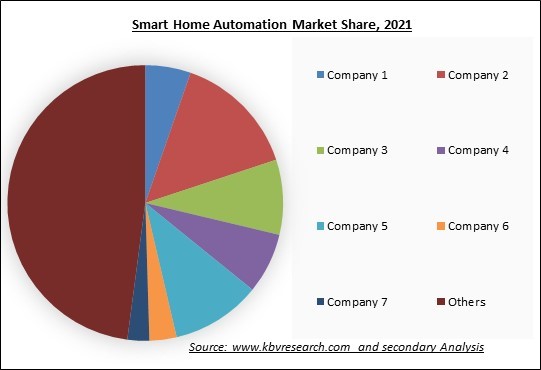
The leading players in the market are competing with diverse innovative offerings to remain competitive in the market. The below illustration shows the percentage of revenue shared by some of the leading companies in the market. The leading players of the market are adopting various strategies in order to cater demand coming from the different industries. The key developmental strategies in the market are Acquisitions.
Smart homes are capable of completing sophisticated tasks, such as automatically illuminating evacuation routes in the event of a fire alarm in addition to basic tasks, like closing curtains. Security cameras, utility meters, and thermostats are just a few examples of household appliances that now have connectivity as a high-end novelty. The trend of connectedness is anticipated to spread over the coming years to the point where it practically permeates every appliance and piece of equipment in a home. But one of the major benefits of employing a smart home automation system is that it allows the user to remotely monitor their entire house.
Data is transmitted across electrical power lines in a process known as power line communication. The use of the same lines to transmit data and transmit 110V/240V, and 50Hz/60Hz signals avoids the need for separate networks for power and data. As a result, there is more flexibility and a reduction in installation and retrofitting expenses. The adoption of smart home goods that can operate at the touch of a button is being fueled by the quick spread of gadgets and smartphones as well as technological breakthroughs in power line technology.
The market for smart homes is incredibly fragmented. Many players are now creating various systems using various technologies. Devices built by the same manufacturer or vendor are simple to integrate and connect, but linking systems created by various manufacturers or vendors is complex and challenging and can also lead to unreliable services, limited functionality, and incompatibility problems. Compatibility problems with different devices pose a hindrance to the development of this sector. End users, therefore, frequently install devices that can only be managed through the manufacturer's app.
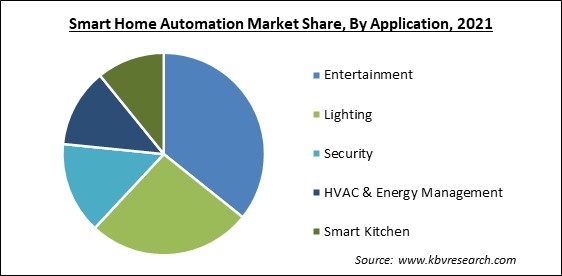
Based on the Component, the Smart Home Automation Market is segmented into Hardware, Software, and Service. In 2021, the hardware segment acquired the largest revenue share of the smart home automation market. The growth of this segment of the market is primarily driven by the rising need for energy-efficient lighting systems as well as other home automation solutions.
On the basis of Technology, the Smart Home Automation Market is segregated into Cellular, Wireless, and Others. In 2021, the wireless segment witnessed the highest revenue share of the smart home automation market. Wireless technology is becoming more often used in smart home automation systems since it is less intrusive, requires less setup cost, and is easier to operate. While there is a growing need for technologically advanced solutions, there is also a growing desire for cost-effective solutions.
By Application, the Smart Home Automation Market is divided into Security, Lighting, Entertainment, HVAC & Energy Management, and Smart Kitchen. In 2021, the smart kitchen segment recorded a significant revenue share of the smart home automation market. The rising growth of the segment is majorly attributed to the fact that smart kitchen significantly streamlines several kitchen works. It allows the user to operate and adjust microwave as well as induction stoves through voice commands.
| Report Attribute | Details |
|---|---|
| Market size value in 2021 | USD 70.7 Billion |
| Market size forecast in 2028 | USD 187.8 Billion |
| Base Year | 2021 |
| Historical Period | 2018 to 2020 |
| Forecast Period | 2022 to 2028 |
| Revenue Growth Rate | CAGR of 15.2% from 2022 to 2028 |
| Number of Pages | 221 |
| Number of Tables | 373 |
| Report coverage | Market Trends, Revenue Estimation and Forecast, Market Share Analysis, Segmentation Analysis, Regional and Country Breakdown, Competitive Landscape, Companies Strategic Developments, Company Profiling |
| Segments covered | Component, Application, Technology, Region |
| Country scope | US, Canada, Mexico, Germany, UK, France, Russia, Spain, Italy, China, Japan, India, South Korea, Singapore, Malaysia, Brazil, Argentina, UAE, Saudi Arabia, South Africa, Nigeria |
| Growth Drivers |
|
| Restraints |
|
Region-Wise, the Smart Home Automation Market is analyzed across North America, Europe, Asia-Pacific, and LAMEA. In 2021, North America held the largest revenue share of the smart home automation market. A huge consumer base along with prominent manufacturers within the region are complementing the growth of the regional smart home automation market. Moreover, various regional countries, like the United States, are early adopters of advanced and cutting-edge technologies.
Free Valuable Insights: Global Smart Home Automation Market to reach USD 187.8 Billion by 2028
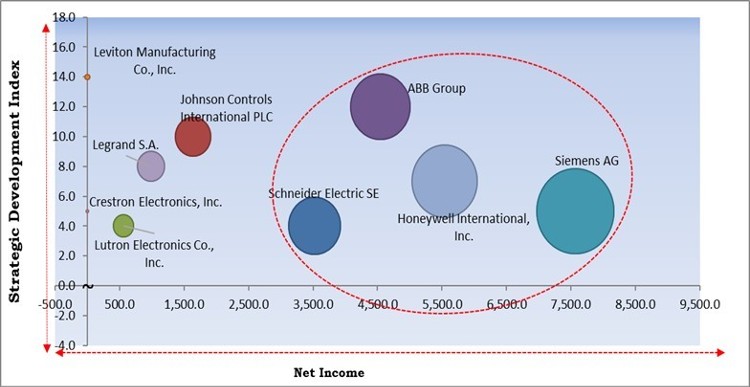
The major strategies followed by the market participants are Acquisition. Based on the Analysis presented in the Cardinal matrix; Siemens AG, Honeywell International, Inc., ABB Group and Schneider Electric SE are the forerunners in the Smart Home Automation Market. Companies such as Leviton Manufacturing Co., Inc., Johnson Controls International PLC, Legrand S.A., Crestron Electronics, Inc.
The market research report covers the analysis of key stake holders of the market. Key companies profiled in the report include ABB Group, Siemens AG, Schneider Electric SE, Johnson Controls International PLC, Honeywell International, Inc., Leviton Manufacturing Co., Inc., Legrand S.A., Crestron Electronics, Inc., Ingersoll Rand, Inc., and Lutron Electronics Co., Inc.
By Component
By Application
By Technology
By Geography
The Smart Home Automation Market size is projected to reach USD 187.8 billion by 2028.
Enhanced Safety And Security Of The House are driving the market in coming years, however, Compatibility Challenges And Interoperability Issues restraints the growth of the market.
ABB Group, Siemens AG, Schneider Electric SE, Johnson Controls International PLC, Honeywell International, Inc., Leviton Manufacturing Co., Inc., Legrand S.A., Crestron Electronics, Inc., Ingersoll Rand, Inc., and Lutron Electronics Co., Inc.
The expected CAGR of the Smart Home Automation Market is 15.2% from 2022 to 2028.
The Entertainment segment acquired maximum revenue share in the Global Smart Home Automation Market by Application in 2021 thereby, achieving a market value of $63.9 billion by 2028.
The North America market dominated the Global Smart Home Automation Market by Region in 2021, and would continue to be a dominant market till 2028; thereby, achieving a market value of $65 billion by 2028.
Our team of dedicated experts can provide you with attractive expansion opportunities for your business.
